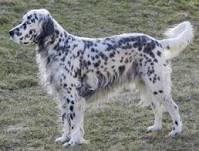English Setter
General
The history of the English Setter goes back to the 14th century and is one of the oldest breeds of gundogs and is used for bird setting and retrieving. The breed is part of the setter group, which includes the red Irish Setters, Irish Red and White Setters, and black-and-tan Gordon Setters.
The AKC describes the breed as elegant but solid dogs of beauty and charm. The word 'belton' unique to the breed, describes the speckled coat patterns of colours, being liver, lemon and orange among them.
These are working dogs and tend to get on well with other dogs and people and are known to be wonderful family dogs. They love to be included in all family activities and are ideal to take on a long walk, jog, or hiking.
The history of the English Setter goes back to the 14th century and is one of the oldest breeds of gundogs and is used for bird setting and retrieving. The breed is part of the setter group, which includes the red Irish Setters, Irish Red and White Setters, and black-and-tan Gordon Setters.
The AKC describes the breed as elegant but solid dogs of beauty and charm. The word 'belton' unique to the breed, describes the speckled coat patterns of colours, being liver, lemon and orange among them.
These are working dogs and tend to get on well with other dogs and people and are known to be wonderful family dogs. They love to be included in all family activities and are ideal to take on a long walk, jog, or hiking.
Is this the right dog for you?
This is a working breed and requires a lot more exercise than other dogs. Long daily walks are required, or else you can take this dog jogging or hiking with you. What this breed also loves is a long run, so if you have a fenced in area near you, a half hour running around daily would make for a very happy dog. Do bear in mind that the skeletons of pups are not completely calcified until they are 2 years old, so pups and young dogs should not receive too much vigorous exercise - do speak to your vet about this. After this breed has had its daily exercise, it is normally happy to lie down next to its people for a nice snooze.
Although they love people and are very clever, they are not always the easiest to train and can be rather stubborn and wilful. This is the norm' for dogs that have been bred to be independent. Positive reinforcement methods are the best way to train this dog and you must be totally consistent, and rather than one long training session, have short training sessions, bringing them into your daily life.
Due to their love for people, they do not do well being left alone for long periods of time. Early Alone Time training should be done and maintained, to prevent separation anxiety from developing, which could result in excessive barking and destruction when you are not home.

Should you have 2 of the same, or 2 pups together?
On average the English Setter gets on very well with dogs of the same breed, however you must make sure that your dog has been well socialized so that it will accept another dog into the home.
When it comes to which sex get on better, your best bet is one male and one female (both sterilized), or 2 males together. Never two females. The vast majority of the time two females will get on well until about 8 - 9 months of age and thenm fighting for position tends to occur. When males have the odd altercation, it tends to be over quickly, but with females, it just intensifies and often the only solution is for one of the females to be rehomes. This is not just for this breed, but in general.
Having two pups from same litter is not a good idea. Most people think that the pups will be happier with a playmate and won’t fight if they are family.Your pup should be at least 5 months old, before you consider bringing in another pup. This allows the pups to grow to their full potential and not become over dependent on one another. The truth of the matter is that your two pups are likely to:
Bond with each other to the exclusion of you
On average the English Setter gets on very well with dogs of the same breed, however you must make sure that your dog has been well socialized so that it will accept another dog into the home.
When it comes to which sex get on better, your best bet is one male and one female (both sterilized), or 2 males together. Never two females. The vast majority of the time two females will get on well until about 8 - 9 months of age and thenm fighting for position tends to occur. When males have the odd altercation, it tends to be over quickly, but with females, it just intensifies and often the only solution is for one of the females to be rehomes. This is not just for this breed, but in general.
Having two pups from same litter is not a good idea. Most people think that the pups will be happier with a playmate and won’t fight if they are family.Your pup should be at least 5 months old, before you consider bringing in another pup. This allows the pups to grow to their full potential and not become over dependent on one another. The truth of the matter is that your two pups are likely to:
Bond with each other to the exclusion of you
- Will stress without the other dog being around
- Fight with each other
- Be more destructive and boisterous
- Two pups together often leads to one being more assertive and the other more submissive. This could well end up in a situation where the more submissive dog will never develop its full potential.
- Mature later
Do they get on with other dogs?
On average yes they are very social. However, dont just take this for granted, make sure you take your pup to puppy school to get the basic social skills and then keep the social skills in place with regular socializing.
Do they get on with other dogs?
On average yes they are very social. However, dont just take this for granted, make sure you take your pup to puppy school to get the basic social skills and then keep the social skills in place with regular socializing.
Do they get on with other animals?
They have a very high prey drive, so do not always do well around small animals.
They have a very high prey drive, so do not always do well around small animals.
Are they good with children?
This breed, on average are very good with kids and tend to be very tolerant. One must always teach children how to interact with a dog, especially small children and not allow them to pull tails and ears and how to respect dogs. Dogs and children should always be supervised.
This breed, on average are very good with kids and tend to be very tolerant. One must always teach children how to interact with a dog, especially small children and not allow them to pull tails and ears and how to respect dogs. Dogs and children should always be supervised.
Health
This breed is prone to health issues such as elbow dysplasia, deafness, hypothyroidism, and canine hip dysplasia (CHD). It is also prone to epilepsy, Osteochondrosis Dissecans (OCD) and progressive retinal atrophy (PRA).
“In today’s age, with the rising cost of veterinary care, it really is a wise decision to consider medical insurance for your pets. Depending on the plan you choose, you can ensure that if your pet does develop one of the health issues the breed is prone too, that you will be covered –additionally, just knowing that any accident your pet may have will be covered, will out-weigh the monthly insurance fee for most pet owners. Our own personal choice is Genricpet as they have a ‘no limit’ policy and their rates are comparable to the rest of the industry. To find out the questions and things to look for in a Medical Insurance, please just follow this link”
This breed is prone to health issues such as elbow dysplasia, deafness, hypothyroidism, and canine hip dysplasia (CHD). It is also prone to epilepsy, Osteochondrosis Dissecans (OCD) and progressive retinal atrophy (PRA).
“In today’s age, with the rising cost of veterinary care, it really is a wise decision to consider medical insurance for your pets. Depending on the plan you choose, you can ensure that if your pet does develop one of the health issues the breed is prone too, that you will be covered –additionally, just knowing that any accident your pet may have will be covered, will out-weigh the monthly insurance fee for most pet owners. Our own personal choice is Genricpet as they have a ‘no limit’ policy and their rates are comparable to the rest of the industry. To find out the questions and things to look for in a Medical Insurance, please just follow this link”
Do’s and Dont’s
Do’s
Don’t
Do’s
- Do get your pup from a KUSA registered breeder and do read the articles on Breeders and also choosing a pup
- Sterilize at approximately 6 months of age.
- Do take your pup for socialization - pups should start at 8 weeks of age and this should not be missed - lays the foundation for future social interactions.
- Do continue the socialiazation - keeps solid social skills in place
- Give daily, regular exercise which this breed really needs and if possible an area where they can really run.
- Supply chew toys and mental stimulation when left alone.
- Teach Alone Time Training from a pup and keep it up
- Allow your dog to be part of the family
- Give regular brushing and annual vacs.
- Supply mental games such as behaviour games, scenting games etc in the garden to mentally stimulate this breed.
- Take your dog for basic training and keep simple house rules in place
Don’t
- Don't use aversive training methods.
- Leave this breed outside alone – behaviour problems will develop


